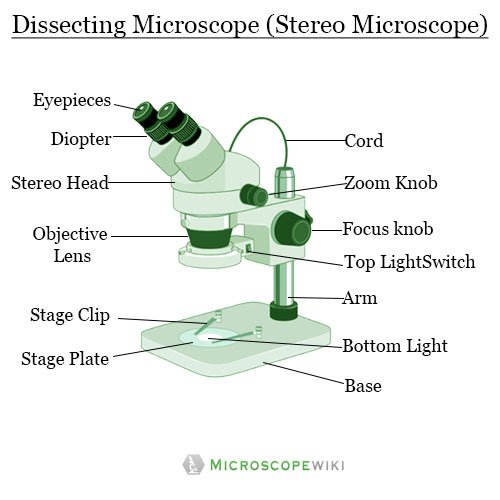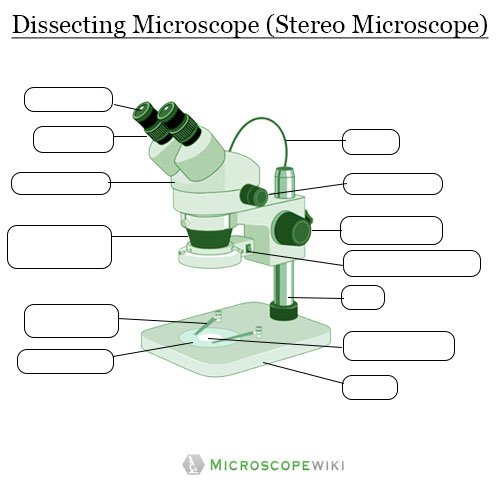As the name suggests, a dissecting or a stereoscopic microscope helps in better viewing of samples while performing dissection.
Dissecting microscope is an optical microscope that is used for low magnification of a sample. Typically, these microscopes are used with light being emanated from the surface of the sample rather than transmitting light through it.
Dissection microscopes appear to be similar to compound microscopes but there is a fundamental difference that separates the two. While the compound microscope creates a 2D image of the specimen, dissecting microscope creates a 3D image making it more useful in low zoom magnification of specimens.
In a dissecting microscope, an offset image is created in each eyepiece thereby creating an image with a distinct depth of field.
Types of dissecting microscopes
- Stereo Zoom Dissecting Microscope
- Stereo Zoom boom stand Microscope
- Digital Tablet Dissection Microscope
- Single Power Stereo Dissection Microscope
- Dual Power Dissecting Microscope
- Single Magnification Handheld Pocket Microscope
1. Stereo Zoom Dissecting Microscope
- These types of dissecting microscopes are either binocular or trinocular and they typically have a magnification range of 6x – 45x.
- The advantage of this microscope is that they can be attached to a digital camera to view the images.
- The magnification of the stereo zoom dissecting microscope can be changed by adding different eyepieces or by adding auxiliary objectives
2. Stereo Zoom boom stand microscope
- It is similar to the stereo zoom microscope, but this microscope has a large base and a very large stage for viewing large samples.
- In this microscope also the magnification factor can be altered by adding the auxiliary eyepieces and objectives.
3. Digital Tablet Dissection Microscope
- This type of microscopes are the most high-end among the dissecting microscopes.
- They have the latest technology incorporated and they have a touch screen LCD camera and have a high megapixel digital camera for capturing images and recording videos that can be transferred instantaneously using an USB cable.
- These microscopes have auxiliary eyepieces that are used to increase or decrease the magnification ranges that are between 6.7x-45x.
- These microscopes also have LED illuminators at the top and bottom that function independently in illuminating the specimens.
4. Single Power Stereo Dissection Microscope
- As the name suggests, this microscope has only single power magnification and this dissection microscope has only a fixed magnification range.
- This type of stereo microscope has a built-in objective lens that are fixed and only the eyepieces can be changed to change the magnification.
5. Dual Power Dissecting Microscope
- This microscope has dual objective lens that are parcentered, achromatic and parfocalled.
- This microscope is a dual-powered dissecting microscope of 10x-30x with an ability to rotate 360° making it ideal for viewing and focussing better to view samples.
- By rotating the lenses, users can change the magnification of image.
- Another feature of this microscope is that it features a high intensity LED lamp that illuminates the surface of the specimen to be observed.
6. Single Magnification Handheld Pocket Microscope
- This is also a single power magnification dissecting microscope that has two magnification ranges.
- This microscope, as the name suggests, is a handheld device and doesn’t require light to illuminate the sample.
- The portability, compact architecture of this microscope makes it a useful component in a few fields of study.
Dissecting microscope Parts

Labeled Diagram of Dissecting microscope (Stereoscopic and Stereo microscope)
A typical stereo microscope has 6 major parts which are:
- LED Illuminators: Typically dissecting microscopes have an LED light that that illuminates the exhibit that needs to be observed.
- Eyepiece: Each dissecting microscope has two eyepieces that is used to focus on the light has divergent pathways. One pathway into the specimen and another out of the specimen. Both the eyepieces have their different power of magnification. And in order to augment the magnification, the microscope employs auxiliary eyepieces.
- Objective lens: Objective lenses, akin to eyepieces have different powers of magnification and can be used to focus on the specimen. This lens can be used to focus the image on a digital camera and auxiliary objectives are used to improve magnification.
- Stage: Stage, as the name implies, is where the specimen is put for observation through the microscope and the stage is large in a few types of dissecting microscopes to enable the viewing of larger specimens
- Optical System: The optical system is housed between the fixed magnification and zoom magnification and it is used to offer fixed-focus lensing
- Digital Camera: A digital camera is technically not a part of the dissecting microscopes, but it is usually used to capture the magnified images and is also used to capture videos that can be used for further analysis.
Applications
- It is widely used in hospitals for microsurgeries
- It is used in the field of palaeontology to analyse and study fossils
- It is used in entomology which studies the insects in detail
- Dissecting microscopes find use in biological research processes
- It is used in the field of botany to study the plants and other plant structures
- It is used by technicians in the repair of circuit boards where the low power magnification is sufficient
- It finds use in pathology to study the infections and identify the pathogens causing them
- Stereo microscopes also find utility in watch repair industry to examine the small parts in the watch
Advantages
- It finds use in several fields where low magnification is required and thus is one of the most versatile types of microscopes
- The ability of attaching the digital camera to the microscope makes it easier to capture high quality images and videos of the specimens
- Dissecting microscopes have two different light pathways allowing for a greater depth effect in producing 3D images of specimens and this help in better analysis
- Dissecting microscopes allow for viewing the specimens in whole and not in pieces
- They are easy to use as they are comparatively light and portable
Disadvantages
- Dissecting microscopes are costly rendering their use at a common level difficult
- The Galilean optical systems that are used in these microscopes are costly to acquire and because it is an essential part, it can’t even be avoided
- The low magnification power of these microscopes is a challenge because it can’t observe tinier organisms
Dissecting microscope (Stereo microscope) Worksheet – Free Download

Click here for : Answer key
Q1. What is the difference between compound microscope and dissecting microscopes?
A. Both the microscopes are optical microscopes that use visible light to create image of specimens. The main difference is that dissecting microscopes are used to view the surface of the specimen, while the compound microscope is used to see through the specimen
Q2. Working principle of a dissection microscope
A. The working principle of dissecting microscope depends on two light pathways that are used by microscope’s eyepiece and objective to create a 3D image that gives a distinct depth effect to enable users to observe the surfaces of the specimens. The dissecting microscope works typically with two magnification systems which are fixed (primary) and zoom magnification. The primary magnification uses two objective lens to offer a degree of magnification and the zoom or auxiliary magnification allows for viewing the sample at various magnifications ranges continuously.
Q3. What is the highest total magnification of a dissecting microscope?
A. The typical magnification range of a dissecting microscope is 6x – 40x. However, the highest magnification range that can be achieved is 100x
Q4. Why is a stereomicroscope also called a binocular dissecting microscope?
A. A stereomicroscope also called a binocular dissecting microscope because it can create 3D images
References:
- https://www.microscopeinternational.com/what-is-a-stereo-microscope/
- https://microbenotes.com/dissecting-microscope/
- https://en.wikipedia.org/wiki/Stereo_microscope
- https://www.leica-microsystems.com/products/stereo-microscopes-macroscopes/dissecting-microscopes/
- https://www.microscopemaster.com/dissecting-stereo-microscope-parts-and-functions.html
- https://www.microscope.com/specialty-microscopes/dissecting-microscopes
- https://www.microscopeworld.com/t-stereo_zoom_microscopes.aspx
- https://microscopeinternational.com/dissecting-microscope-uses/